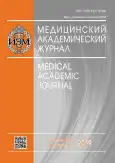АНТИМИКРОБНАЯ АКТИВНОСТЬ ЛИЗОЦИМА В ОТНОШЕНИИ LISTERIA MONOCYTOGENES В РАЗЛИЧНЫХ УСЛОВИЯХ СРЕДЫ
- Авторы: Берлов МН1, Легковой СВ2, Умнякова ЕС1, Кокряков ВН1,2
-
Учреждения:
- ФГБНУ «Институт экспериментальной медицины»
- Санкт-Петербургский государственный университет
- Выпуск: Том 19, № 1S (2019)
- Страницы: 161-162
- Раздел: Статьи
- Статья опубликована: 15.12.2019
- URL: https://journals.eco-vector.com/MAJ/article/view/19378
- ID: 19378
Цитировать
Полный текст
Аннотация
Исследовалось антимикробное действие in vitro лизоцима из лейкоцитов человека на грамположительную бактерию Listeria monocytogenes в различных условиях среды. Показано, что в буфере с низкой ионной силой (без NaCl) требуются на порядок меньшие дозы лизоцима для проявления микробоцидного эффекта, чем в присутствии 0,075 или 0,15 M NaCl. Фаза роста бактериальной культуры не оказывает существенного влияния на антимикробную активность лизоцима. Полученные результаты согласуются с двухстадийным механизмом антимикробного действия лизоцима, включающим ферментативное и неферментативное действие.
Ключевые слова
Полный текст
Об авторах
М Н Берлов
ФГБНУ «Институт экспериментальной медицины»
С В Легковой
Санкт-Петербургский государственный университет
Е С Умнякова
ФГБНУ «Институт экспериментальной медицины»
В Н Кокряков
ФГБНУ «Институт экспериментальной медицины»; Санкт-Петербургский государственный университет
Список литературы
- Selsted ME, Martinez RJ. Lysozyme: primary bactericidin in human plasma serum active against Bacillus subtilus. Infect. Immun. 1978;20:782-791.
- Düring K, Porsch P, Mahn A, et al. The non-enzymatic microbicidal activity of lysozymes. FEBS Lett. 1999;449:93-100.
- Ibrahim HR, Matsuzaki T, Aoki T. Genetic evidence that antibacterial activity of lysozyme is independent of its catalytic function. FEBS Lett. 2001;506:27-32.
- Davies RC, Neuberger A, Wilson BM. The dependence of lysozyme activity on pH and ionic strength. Biochim. Biophys. Acta. 1969;178:294-305.
- Berlov MN, Korableva ES, Andreeva YV, et al. Lactoferrin from canine neutrophils: isolation and physicochemical and antimicrobial properties. Biochemistry (Moscow). 2007;72:445-451.
- Muschel LH, Jackson JE. The reactivity of serum against protoplasts and spheroplasts. J. Immunol. 1966;97:46-51.
Дополнительные файлы







